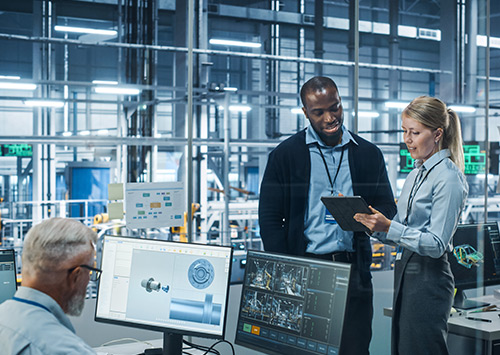- Services
Technology Capabilities
Technology Capabilities- Product Strategy & Experience DesignDefine software-driven value chains, create purposeful interactions, and develop new segments and offerings
- Digital Business TransformationAdvance your digital transformation journey.
- Intelligence EngineeringLeverage data and AI to transform products, operations, and outcomes.
- Software Product EngineeringCreate high-value products faster with AI-powered and human-driven engineering.
- Technology ModernizationTackle technology modernization with approaches that reduce risk and maximize impact.
- Embedded Engineering & IT/OT TransformationDevelop embedded software and hardware. Build IoT and IT/OT solutions.
- Industries
- GlobalLogic VelocityAI
- Insights
BlogsMarch 15, 2023GlobalLogicIf You Build Products, You Should Be Using Digital Twins
Digital twin technology is one of the fastest growing concepts of Industry 4.0. In the ...
 BlogsJanuary 25, 2023GlobalLogic
BlogsJanuary 25, 2023GlobalLogicDeploying a Landing Zone with AWS Control Tower – Part 3
In this post, we’re going to walkthrough some of the remaining post configuration tasks...
- About
Published on April 22, 2024Retail as a Conspiracy
View all articles Dr. Jim WalshCTOShareRelated Content
Dr. Jim WalshCTOShareRelated Content GlobalLogic25 June 2025
GlobalLogic25 June 2025 GlobalLogic25 June 2025View All Insights
GlobalLogic25 June 2025View All Insights GlobalLogic25 June 2025
GlobalLogic25 June 2025Let's start engineering impact together
GlobalLogic provides unique experience and expertise at the intersection of data, design, and engineering.
Get in touchCross-IndustryI was one of the early buyers of the first release of Apple Vision Pro AR headset early this year. I got up at 5am my time to place an order on-line at the first moment when the device became available for pre-order. I then made an appointment at my local brick-and-mortar Apple Store to pick it up as early as possible on the first Saturday after they shipped. Needless to say, I was excited about this technology (and still am).I got to the store early and waited in line with other eager Vision Pro buyers also picking up their orders. When the store opened and we all filed in, we were each assigned to a store associate for a demo and familiarization session with this new device. While I was overwhelmed by the experience offered by the device itself, what struck me just as forcefully was the nature of the retail experience. The air of excitement in the store was palpable, not only among the group of buyers, but also among the sales associates and even the store manager. I felt like we were all conspiring to share something truly unique, truly special. And that, I think, is the essence of a great retail experience: It’s a conspiracy between the buyer and seller to share a thing of value.
I’ve had this experience a few other times in my life, generally with the owner of a “Mom & Pop” or family enterprise. I particularly remember an experience in India where I bought a leather wing-back chair. I had seen the chair on display at the old Bangalore airport, and because I couldn’t find a retail outlet, I made a visit to the local factory where it was made. The owner of the factory personally showed me around, and actually took my measurements, like I was buying a suit of clothes. They made the chair “to order” and to fit my dimensions (hip-to-knee, length of torso, etc.)! When his workers brought the finished chair to the company apartment where I was staying at the time, you could feel their pride in the finished product. They waited eagerly until I sat in the chair and pronounced it a perfect fit. Years ago, I brought the chair back to the US with me, and it sits proudly in my study to this day, full of very pleasant memories around how it came into my life.
Why are retail experiences like this rare?
Well, when I’ve had them, I was buying something that was at least relatively expensive, and from someone to whom the sale would be significant in some way. In the Apple Vision Pro example, I assume that—in addition to the sales people’s genuine excitement around this new product—the store probably had incentives, a contest, or at least recognition in place for their associates to first learn and then present this new technology. I don’t know that for a fact, but I did get a survey soon afterward, from which I assume (hope) the sales associate was recognized in some way for his great work. In the factory owner example, in addition to their genuine pride in a great product, I think they were hopeful that I’d spread word-of-mouth among my colleagues and fellow ‘ex-pats’ (which I did). In other words, even beyond the money they received, it was worthwhile for someone to deliver an exceptional product and experience.
Notably, none of my best retail experiences were entirely on-line. This being the 21st Century, they all involved the Web: I originally ordered the Apple Vision Pro on-line, and I tracked down the manufacturer of the chair through Google. Other “peak” retail experiences have all likewise involved the Web in some way—education, awareness and so on. But none of my best retail experiences to date have been entirely on-line; all have required a personal touch.
Why is this? Thirty years after the Web came to prominence, why is it not delivering such ‘peak’ retail experiences by itself?
I think it is because of the relative lack of personalization. A critical factor in any ‘conspiracy’—which I believe a great retail experience requires—is collusion between one or more people. Sophisticated websites use machine learning and demographic data to present an experience that is in some ways tailored to the buyer—or at least to a similar type of buyer. However, in my own on-line shopping, I have not yet encountered a retail website that really directly engages me, individually, the way a good human retailer does. My best experiences to date have all required a “human in the loop”.
Back in the early days of the Web I was inspired by a then-recently-published 1993 book called “The One to One Future: Building Relationships One Customer at a Time”, by Don Peppers and Martha Rogers. Peppers’ and Rogers’ thesis was that businesses can prosper by building strong relationships with their best customers, and by growing their share of that customer’s wallet over time. When my team was developing an early e-commerce platform at Apple in the 1990’s, we built in a number of features that enabled automated individualized shopping experiences—such as intelligent cross-selling. But, while we aimed to achieve it, the technology did not exist at that time to truly enable the kind of “mass personalization” and personalized relationships that Peppers and Rogers envisioned. To this day, thirty years later, developing a deep personal relationship with a customer has required a person—a human in the loop. It’s not something the industry has truly been successful at automating.
Earlier attempts at automating ‘personalized’ customer interaction, such as chat-bots and IVR systems, have had limited success. This is largely, I believe, due to the necessarily scripted and programmed nature of these interactions. While some experiences are far better than others, people do not interact naturally on a ‘programmed’ basis—it tends to sound phony unless the system vocabulary is very large, and the options are truly flexible, or even dynamic. That’s exactly what we have in GenAI—interactions that are increasingly open-ended and therefore more human-like.
Could a GenAI-based retail system learn to understand me as an individual—what drives me, what decision criteria I use, what I value in a product? And then map that information to identify the products I would love to buy, and help me understand why I’d love and can afford those products? I believe the answer is an emphatic “yes”, going far beyond traditional ‘propensity to buy’ determinations. The main wildcard here is access to accurate customer behavioral and motivational data and, ultimately, the customer’s willingness to be known deeply by a given system. In general, people are more disclosing to a machine than to other people, because the fear of judgement is reduced. People’s main concern when disclosing information to a machine tends to be the privacy of the information, and concerns about the manner in which that information will be used. These are solvable problems. In particular, I think shopping ‘agents’ will be developed who understand a customer and a customer’s finances and goals intimately—perhaps presenting an anonymized face to the world, for privacy sake.
The other wildcard is how disclosing a retailer is willing to be about the true nature of their products. Mapping an individual customer to a product description only creates loyalty if that customer is truly delighted after receiving and using the product itself. Marketing hype may help sell a product once. But alone, it doesn’t create the kind of “lifetime customer” or increasing “wallet share” that Pepper and Rogers describe in the “One to One Future”. Thankfully, we live in an age of increasing transparency, with customer ratings and reviews now a routine part of the buying experience, and suppliers increasingly honest about sourcing, provenance and other criteria of concern to various individuals. While these systems and data can be—and often are—gamed, they point the way toward a more objective and satisfying retail experience in the future.
I remember Steve Jobs once sent a thoughtful email to the employees at NeXT talking about how retail experiences always involve individual ‘values’—not in a moral sense necessarily, but in terms of the importance they give to certain factors. He gave the example of himself and his wife Laurene considering the purchase of a high-quality European washing machine for their home. He said that the washer produced softer clothes and used less water and laundry soap, and was therefore better for the environment. On the other hand, the washing cycle was longer, so they couldn’t clean as many clothes in the same amount of time. Steve and Laurene opted for the European machine I believe. But you can readily imagine someone with a large family valuing the higher throughput of a cheaper US-made machine above the quality and environmental advantages posed by the more expensive European option. With its natural language understanding, consideration of these kind of value judgements are a very good use case for GenAI. It’s exciting to think of the opportunities for delightful retail experiences for us all, both as consumers, and as sellers, in the one-to-one GenAI future.
Also with GenAI, we have an expanded opportunity to not only create personalized experiences, but personalized products as well. As a simple example, on request a telco analyzes a specific customer’s historic data and voice usage, media viewing habits and other factors—such as payment history—and dynamically creates and prices a product tailored to that specific individual. On a slightly more speculative level—but by no means far-fetched—physical goods can be produced to individual order using GenAI-produced programs and models to drive a combination of industrial robots, 3D printing, CNC milling machines and other computer-controlled manufacturing devices. These technologies exist today and, indeed, are being used to produce products under GenAI control in isolated pockets and on a small scale already. The only speculation is that these approaches will become affordable and widespread.
While it has taken thirty years and counting, I think the technical basis to realize a true “One to One” future is now in place. I think the next thirty years will transform retail almost beyond recognition, by allowing people and AI’s to conspire together to create value and deliver delightful buying experiences. And, not incidentally, create tremendous customer loyalty to those who deliver this service.
